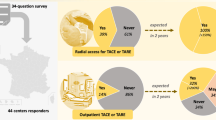Abstract
Purpose
New technologies for microwave ablation (MWA) have been conceived, designed to achieve larger areas of necrosis compared with radiofrequency ablation (RFA). The purpose of this study was to report complications by using this technique in patients with focal liver cancer.
Methods
Members of 14 Italian centers used a 2.45-GMHz generator delivering energy through a cooled miniature-choke MW antenna and a standardized protocol for follow-up. They completed a questionnaire regarding number and type of deaths, major and minor complications and side effects, and likelihood of their relationship to the procedure. Enrollment included 736 patients with 1.037 lesions: 522 had hepatocellular carcinoma with cirrhosis, 187 had metastases predominantly from colorectal cancer, and 27 had cholangiocellular carcinoma. Tumor size ranged from 0.5 to 10 cm. In 13 centers, the approach used was percutaneous, in 4 videolaparoscopic, and in 3 laparotomic.
Results
No deaths were reported. Major complications occurred in 22 cases (2.9%), and minor complications in 54 patients (7.3%). Complications of MWA do not differ from those RFA, both being based on the heat damage.
Conclusion
Results of this multicenter study confirmed those of single-center experiences, indicating that MWA is a safe procedure, with no mortality and a low rate of major complications. The low rate of complications was probably due to precautions adopted, knowing in advance possible risk conditions, on the basis of prior RFA experience.
Similar content being viewed by others
References
Bruix J, Sherman M (2005) Management of hepatocellular carcinoma. Hepatology 42:1208–1236
Makuuchi M, Kokudo N (2010) Clinical practice guidelines for hepatocellular carcinoma. Hepatol Res 40(S):8–9
Livraghi T, Meloni F, Di Stasi M et al (2008) Sustained complete response and complications rates after radiofrequency ablation of very early hepatocellular carcinoma in cirrhosis: Is resection still the treatment of choice? Hepatology 47:82–89
Ikeda K, Seki T, Umehara H et al (2007) Clinicopathologic study of small hepatocellular carcinoma with satellite nodules to determine the extent of tumor ablation by local therapy. Int J Oncol 31:485–491
Lam VW, Ng KK, Chock KS et al (2008) Risk factors and prognostic factors of local recurrence after radiofrequency ablation of hepatocellular carcinoma. J Am Coll Surg 207:20–29
Jones C, Badger SA, Ellis G (2011) The role of microwave ablation in the management of hepatic colorectal metastases. Surgeon 9:33–37
Liang P, Wang Y (2007) Microwave ablation of hepatocellular carcinoma. Oncology 72(S):124–131
Liang P, Wang Y, Yu X, Dong B (2009) Malignant liver tumors: treatment with percutaneous microwave ablation: complications among cohort of 1,136 patients. Radiology 251:933–940
Ong SL, Gravante G, Metcalfe MS et al (2009) Efficacy and safety of microwave ablation for primary and secondary liver malignancies: a systematic review. Eur J Gastroenterol Hepatol 21:599–605
Martin RC, Scoggins CR, McMasters KM (2010) Safety and efficacy of microwave ablation of hepatic tumors: a prospective review of a 5-year experience. Ann Surg Oncol 17:171–178
Zanus G, Boetto R, Gringeri E et al (2011) Microwave thermal ablation for hepatocarcinoma: liver transplanted cases analysis. Transplant Proc 43:1091–1094
Livraghi T, Solbiati L, Meloni MF et al (2003) Treatment of focal liver tumors with percutaneous radio-frequency ablation: complications encountered in a multicenter study. Radiology 226:441–451
Livraghi T, Goldberg SN, Lazzaroni S et al (1999) Small hepatocellular carcinoma: treatment with radiofrequency ablation versus ethanol injection. Radiology 210:655–661
Longo I, Biffi Gentili G, Cerretelli M et al (2003) A coaxial antenna with miniaturized choke for minimally invasive interstitial heating. IEEE Trans Biomed Eng 50:82–88
Goldberg SN, Grassi CJ, Cardella JF et al (2005) Image-guide tumor ablation: standardization of terminology and reporting criteria. Radiology 235:728–739
Yamaura T, Sakamoto H, Amikura K et al (2010) A case of thrombocytopenia after microwave coagulation therapy for multiple metastatic liver tumors. Gan To Kagaku Ryoho 37:2579–2581
Kojima Y, Suzuki S, Sakaguchi T et al (2000) Portal vein thrombosis caused by microwave coagulation therapy for hepatocellular carcinoma: report of a case. Surg Today 30:844–848
Acknowledgments
The authors thank Mrs. Rosalind Roberts for the English editing.
Conflict of interest
The authors declare that they have no conflict of interest.
Author information
Authors and Affiliations
Consortia
Corresponding author
Additional information
This study is conducted for the Collaborative Italian Group using AMICA system. The study group members are listed in Appendix.
Appendix
Appendix
Department heads and participating centres of the Italian Collaborative Group using microwave AMICA system: G. Zanus, General Surgery and Organ Transplantation, Azienda Università, Padova; L. Solbiati, Interventional Oncology, Azienda Ospedaliera, Busto Arsizio (Varese); F. Meloni, Radiology, Ospedale San Gerardo, Monza; A. Noto, Internal Medicine, Ospedale Annunziata, Cosenza; O. Goletti, Surgery, Ospedale di Pontedera (Pistoia); RF. Grasso, Radiology, Università Campus Bio-Medico, Roma; C. Pusceddu, Radiology, Ospedale Oncologico Businco, Cagliari; R. Nani, Radiology, Ospedali Riuniti, Bergamo; M. Mazzucco, Hepatology, USLS17 Este (Padova); G. Poggi, Oncology, IRCCS Fondazione Maugeri, Pavia; R. Santambrogio, Surgery, Ospedale San Paolo, Milano; L. Mezzolla, Internal Medicine, Casa di Cura Villa Verde, Taranto; F. Fiore, Interventional Oncology, Istituto Tumori, Napoli; E. Bissoli, Radiology, Azienda Alta Padovana Camposampiero (Padova).
Rights and permissions
About this article
Cite this article
Livraghi, T., Meloni, F., Solbiati, L. et al. Complications of Microwave Ablation for Liver Tumors: Results of a Multicenter Study. Cardiovasc Intervent Radiol 35, 868–874 (2012). https://doi.org/10.1007/s00270-011-0241-8
Received:
Accepted:
Published:
Issue Date:
DOI: https://doi.org/10.1007/s00270-011-0241-8




